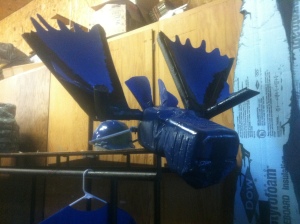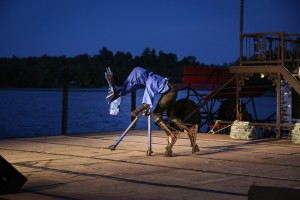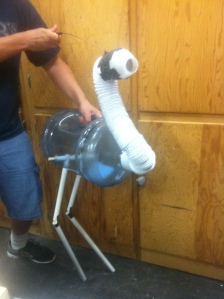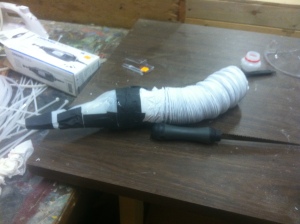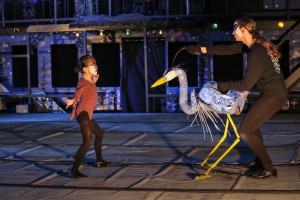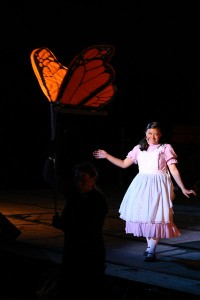 The climax of our show ‘Ziibi’ was going to be a butterfly, and it was going to be awesome. We wanted to end with a ‘wow’! We wanted a huge butterfly, larger than life, ending the show by flying over the audience. Unfortunately, live theatre exists in a world with laws of physics and gravity.
The climax of our show ‘Ziibi’ was going to be a butterfly, and it was going to be awesome. We wanted to end with a ‘wow’! We wanted a huge butterfly, larger than life, ending the show by flying over the audience. Unfortunately, live theatre exists in a world with laws of physics and gravity.
I don’t have pictures of the building process, because it was a frustrating series of trials and errors and dead end ideas. At first we thought we could somehow attach enormous butterfly wings to a quadcopter and flap the wings with the movement of the drone up and down. That led down a path that seemed more plausible of buying or building an ornithopter that could be flown by remote control and have actual flapping mechanics keep the butterfly in flight. Besides being expensive, that also didn’t prove to be practical because of the speed it would have to travel, which would not give us the control we would need for stage. I bought a $50 ornithopter RC bird, that we thought might also be usable as birds in another number for the show. I tried extending the wings into a caterpillar, but the little, light-weight flyer did not have the torque needed for large butterfly wings.
 Then I figured I could build a motorized ornithoper to power the wings, but then suspend it hanging from a pole to control the speed and not have to worry about keep it in flight. I bought a little RC car and destroyed it for the motor. Again, the puny little motor didn’t have nearly enough torque to drive the large wings. Around the same time, I had ordered an ornithopter kit to build a rubberband-powered flyer. It taught me the mechanics needed, but as a small light-weight flyer, it wasn’t what I needed for such a large prop.
Then I figured I could build a motorized ornithoper to power the wings, but then suspend it hanging from a pole to control the speed and not have to worry about keep it in flight. I bought a little RC car and destroyed it for the motor. Again, the puny little motor didn’t have nearly enough torque to drive the large wings. Around the same time, I had ordered an ornithopter kit to build a rubberband-powered flyer. It taught me the mechanics needed, but as a small light-weight flyer, it wasn’t what I needed for such a large prop.
In the end, I built a non-flying ornithopter, which is held on a stick, powered by the puppeteer driving a PVC sleeve up and down along the handle, which powers the rods to flap the wings. Although it was built, my time with it wasn’t finished. It required numerous repairs and replacements, as the wooden dowel rods couldn’t hold the strain from the torque of the wings. Alas, it’s not much of a story, but it was certainly a learning experience.


